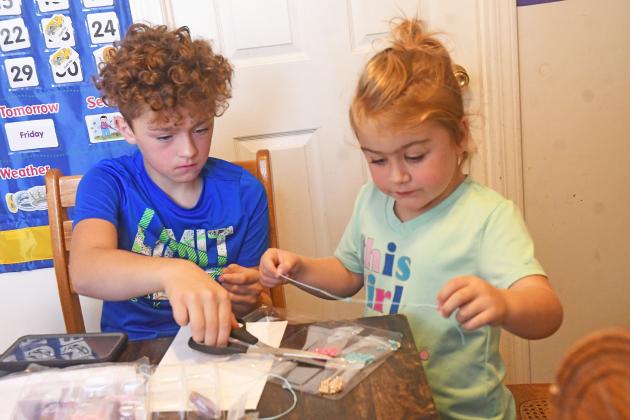Pandemic health concerns prompt some to consider homeschool alternative
Tasha White sits at a table with her children, 5-year-old Emmah and 11-year-old Keagan as her daughter writes her name again and again on a practice sheet and her son works on creating a bracelet with small beads.
Her oldest, 14-year-old Blaydon, sits in the basement, having finished his work in the morning. This has become a typical day in the White household as the family works through everything that comes with first time homeschooling.
The decision was made to homeschool their children due to the ongoing pandemic and the decision by Giltner to not mandate mask wearing. The Whites are not alone.
A recent article published in the Omaha World-Herald noted that as of Sept. 9 the number of filings to homeschool children was up 72.5 percent over the 2019-20 school year, according to the Nebraska Department of Education.
The NDE website also states that due to the unprecedented number of calls and e-mails for parents new to homeschooling based on COVID-19 concerns that their six week processing time has increased. NDE staff are currently working on early July submissions.
For the White family, the unknowns of an ongoing pandemic, combined with their daughter’s health challenges, made it the right decision for them.
“She (Emmah) has a congenital heart defect,” White explained. “She has Tetralogy of Fallot and she’s had two open-heart surgeries. Tetralogy already messes with oxygen and everything so we chose homeschooling to be safe.”
In order to reduce the risk of the brothers bringing the coronavirus home, it was decided that they would also be homeschooled.
White noted that they will continue to homeschool for the indefinite future because the long-term effects of the virus and the potential vaccines are unknown.
“It (vaccines) causes the heart to swell for Emmah,” she voiced. “Unfortunately she can’t even have a flu shot. The vaccine that comes out is going to have some of the virus in it and her body could over-respond.”
Curriculum
Due to her children’s age range, White has implemented two different curriculums. Emmah does her studies in workbooks while Keagan and Blaydon do online classes through Acellus.
“Acellus is online and it’s subscribed,” she said. “We have to pay a monthly subscription for it, but I didn’t feel confident in keeping them where they need to be.”
The online courses also transfer back to Giltner, making it so the boys can stay in their current grade when they return to regular schooling.
“It had to be accredited and I did speak to the superintendent,” she noted. “He told us that this is one of them that they even use at school. They do it whenever they have it, on their computer, their phones. They kind of do it a little bit here and there.
“They have to be able to test at the same level as their class to get back in with their class,” she continued. “They don’t want to be held back. They want to stay with the friends they’ve had from the beginning.”
White has a general routine that sees the children doing classes from 9-11 a.m. on most days. A plus that she has found has been flexibility in their scheduling. White noted that she has always been a stay-at-home parent while her husband has worked.
Having no set hours that they have to study gives the family the opportunity to take breaks, go outside and take field trips when other schools are in session.
Challenges
Making the jump from public to homeschooling comes with many changes, and not all of them are easy.
The most noticeable pushback has come from Emmah, White said, explaining that this comes from her not seeing her brothers sitting down to write as she does. She added that there are some difficulties teaching Emmah to write as she is right-handed while White is left-handed.
There have been upsides as well. White voiced that being able to teach her children, having them at home and knowing that they are all safe has been very refreshing for her.
“Sometimes it’s hard and challenging,” she admitted. “I’m not going to say it’s not. Some days there’s a lot of pushback from the children, some days it’s really nice.”
Helping to alleviate some of the difficulties is the amount of time the family spends outdoors. One of the things that White has been looking forward to is taking field trips with the kids. When they can’t stray too far from home, the children instead spend their time outside playing.
“We’re outside a lot,” she described. “We do some schooling outside because it’s nice and we just love to be outside. We’re always on the trails. When it gets colder I don’t know what we’re going to do for activities.”
Lessons learned
Reflecting on their journey, the first thing White said was that she had to give props to teachers and all they do.
Knowing that this is her first time around, she added that she is still learning as they go along. The first few months have shown her not to be too hard on herself.
“My husband has to help the oldest,” she said. “He’s in algebra and I don’t remember any of that. It’s a good thing that they can ask questions and I can get them a tutor online if they need it for any reason.”
While there may be places the children have struggled or needed more help, she voiced that this has let them pursue topics that they are passionate about.
The time at home has also given them the opportunity to learn about life skills and everything that goes into taking care of a home.
“They all help with chores and they’re all learning how to do more cleaning, cooking and things that they’re going to need to know when they’re older,” she explained.
Overall, White voiced that she loves being able to be with her kids and to know that they’re safe while still getting an education.
“No one can protect your kids like you can,” she said. “We don’t go anywhere. We don’t do anything. It’s been long, but it’s for a reason and that reason is to protect the children and keep them educated.”
Student’s perspective
White’s eldest son, Blaydon, took a break from playing on the trampoline with his siblings to share his thoughts on the changes they have gone through this year.
“It’s pretty fun, but I miss going to actual school and doing sports,” he said.
He added that he does get to stay active and spends most of the day outside after he finishes his school work.
“I just get whatever is assigned that day, get it done and go outside,” he explained. “That’s one thing better than normal school.”
Blaydon voiced that while he doesn’t get to see his classmates as much now that they are homeschooled, he has kept in contact with them over the phone.
When he’s not studying, playing outside or playing video games, Blaydon noted that he has been helping his mother around the house and with teaching his younger siblings.
He added with a laugh that being around his family all day was nice at first, but it’s getting tougher.
Long-term perspective
While White has been learning many things as she goes, she hasn’t been alone. Lisa Hunnicutt, a long-time homeschooler, has been assisting area families like the Whites make the transition.
“I’ve confided in her a lot because she knows what she’s doing,” White said. “I really do look to her and she sends me the information that I need to know.”
Hunnicutt has been homeschooling her children since 2004 and has only ever homeschooled them.
“We felt that we could educate them and make sure they were going at their pace and to their abilities,” she said. “Also (we wanted) to get them grounded spiritually. I think those are the main reasons.”
Hunnicutt uses the skills she has learned in the past 16 years to help other families navigate through the decisions that might lead them to home-based education.
“It’s something that each family makes their own decisions and homeschooling looks different for everyone and every child,” Hunnicutt explained. “Some families choose to do it right away and others may not choose it until later. Everybody has their different reasons for doing it.”
Hunnicutt reported that this past year has been one of the largest as far as new people reaching out for insight and information.
When asked about families choosing to pull their children out of school due to the pandemic, she voiced that it is a personal choice.
“I think some are very much trying to keep their kids safe from the virus, whether they feel like the school is not doing enough or doing too much,” she said. “Some might have thought about it for years and never really known how or if they should take this step.”
Currently, Hunnicutt has children in 11th, ninth, sixth, fourth and first grade. Her two oldest are part-time students at Giltner where they each take classes so they can participate in school activities.
She explained that in Nebraska if a student takes two classes at a high school then they can participate in NCAA sports and programs like speech. This lets her children receive their education at home while still being involved in group activities.
For those who are at the early stages of exploring the homeschooling option, she voiced that there are two steps that need to be done first.
“You need to register with the state and then after that try to figure out what curriculum or program you want to do,” she said.
Homeschool advice
Throughout the years, Hunnicutt has learned many tips and lessons to share with those just beginning their journey.
“Mainly it’s just knowing that every day is going to be different,” she said. “Whether you’re homeschooling or in public school, no day goes exactly how you planned. There are always interruptions in life.”
She noted that a lot of the challenge is just figuring out what the kids need or what the day is going to look like. While she has found that some people have their days and years planned out, others know an approximate guess and go by that.
Having that ability to change schedules and go with the flow is one of the reasons Hunnicutt has found sways other family’s decision to switch.
“It’s the ability to have your kids slow down or speed up,” she voiced. “I’ve had a child who was doing math well advanced above their grade level and then I’ve had kids who I’ve had to slow down on the reading. It’s being able to both speed up and slow down based on the kids and what their needs are.”
While Hunnicutt explained that they don’t have set schooling hours, they do try to have school primarily in the morning. The older children would often carry on into the afternoon, she said.
“Every day’s a little different if we have appointments or something, but we try to have a set schedule,” she said. “There are days when if something comes up in the morning then things get shoved back.”
Reflecting on their decision to teach their children at home from day one, Hunnicutt voiced that she has loved their homeschool journey.
“I have loved being able to be with my kids more than most people have the opportunity to,” she said. “I love watching them grow, watching them learn and the light bulbs go off.”





